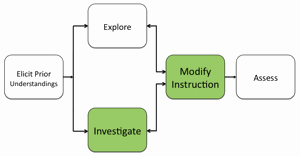Paleoclimate Reconstruction Lab
In this lab investigation, students will reconstruct past climates using lake varves as a proxy. They will explore the use of lake varves as climate proxy data to interpret long-term climate patterns and understand annual sediment deposition and how it relates to weather and climate patterns.

1. Combine all individual core graphs and place together on a wall in the classroom. Have students from Core 1b – Core 10 fold the left margin back on the y-axis. Be sure to include the completed Core 5 graph that is provided in the Paleoclimate Reconstruction Core Data Handout.
2. Instruct students to answer Analysis Questions #3-8 in their Investigation Guide.
Important Note: In question 6, students will interpret Cores 5-10 to be indicative of a cooling trend due to the thin varve layers in the data set. Students are then provided additional climate proxy data that informs them that those varve years are actually warm climate years. They are also provided additional information that tells them that the glacier has retreated different distances durings the climate record period. At this point, you may wish to review some of the slides used at the beginning of the investiagtion that explains that as temperature increases a glacier begins to retreat away from a glacial lake. This decreases the sediment supply to the lake that in turn causes thinner varve layers.
Implementation Suggestion:
- An effective instructional strategy is to have students first answer a question individually and then discuss the student responses before proceeding to the next analysis question.
3. Discuss students' responses to the analysis questions.
4. If at the end of the lab activity, students are having difficulty understanding that annual sediment deposition is related to weather and climate patterns, use the paleoclimate record to discuss this relationship. Within Cores 5-10 of the paleoclimate record, the varves gradually become thinner. This is due to the warming of the climate. As the temperature increases, the glacier begins to retreat away from the glacial lake. This decreases the sediment supply to the lake that in turn causes thinner varve layers. In addition, note to students that the annual sediment deposition is related to the weather during each varve year. A thinner varve generally indicates a cooler climate with less meltwater and hence less sediment transported to the lake, while a thicker varve generally indicates a warmer climate with more meltwater and hence more sediment transported to the lake. Eventually the annual sediment layers accumulate in a lake leaving a long term record.
Note: It is important for the students to understand that the varve years can be scaled to approximate calendar years. As an example, varve year 5685 can be associated with an approximate calendar age of 15,100 years ago.
Materials Needed:

Slideshow
Handouts
Assessment Information
Teacher Resources/Content Support
